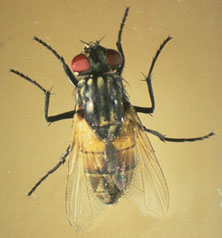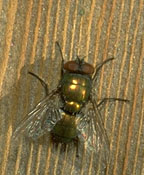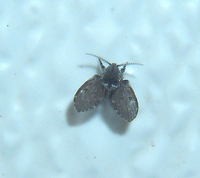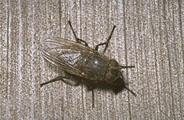Quick facts
- During the summer, flies are attracted to human and animal waste and garbage, so they are sometimes called "filth flies." They can transmit diseases such as diarrhea and dysentery.
- Other flies can be seen in and around homes during late summer and fall as they look for warm places to hide for the winter. They are a nuisance and don't harm people or property.
Preventing and controlling filth flies
The most effective way to control them is to keep your home and yard clean:
- Tie plastic garbage bags tightly to reduce odor.
- Clean garbage cans regularly to remove food and odors.
- Use garbage cans with tight-fitting lids and place as far away as possible from your home.
- Remove animal manure, rotting mulch, lawn clippings and dead birds and animals from your yard.
- Cover compost piles with black plastic sheeting.
- Use 14- to 16-mesh screen on doors and windows.
- Once they get inside, a simple flyswatter is effective against small numbers of flies. Sticky flypaper rolls can be used to trap flies and are available at most hardware stores. Hang flypaper out of reach of children and pets.
Life cycle
- All flies belong to the insect order Diptera, meaning "two-winged." Most other adult insects have four wings.
- Flies have four life stages: egg, larva, pupa and adult. Eggs are laid in a variety of decaying organic material and hatch into pale, legless maggots.
- When development is complete, the maggots search for a dry place to pupate. The pupa is the immobile stage characterized by a hard, dark brown shell.
- The adult flies may emerge in as little as seven to fourteen days.
Using insecticides
Although insecticides are not effective in long-term control, they can be used to temporarily reduce fly numbers.
Treat outdoor surfaces in areas of high fly activity, especially around doors, windows, garbage cans and dog houses, with a residual spray of an EPA-approved insecticide such as permethrin or bifenthrin. Be sure that the product is labeled for the site you intend to treat.
Hiring a licensed pest control operator to treat heavy infestations of flies may be the best approach. Certain insecticides are available only to pest control operators.
Spot-treat large numbers of flies indoors with an aerosol spray labeled for flying insects, such as pyrethrin or tetramethrin. This is a short-term solution and will not solve an ongoing problem.
CAUTION: Mention of a pesticide or use of a pesticide label is for educational purposes only. Always follow the pesticide label directions attached to the pesticide container you are using. Be sure that the area you wish to treat is listed on the label of the pesticide you intend to use. Remember, the label is the law.
Common filth flies
Musca domestica
Found throughout the world, the house fly is one of the most common of all insects.
- Adults are dull, medium-gray flies, 1/6- to 1/4-inch long with four dark stripes on the thorax. They have sponging, non-biting mouthparts for sucking up liquified foods.
- Female house flies live for three or four weeks and lay batches of 75 to 100 small, white, oval eggs, usually in garbage, but also in manure and decaying vegetation.
- House flies are strong fliers and can fly up to 20 miles, although they are found primarily within two miles of the larval food site.
- When feeding, house flies regurgitate liquid from the stomach to dissolve food, then use their sponging mouthparts to suck it up.
- They leave fecal spots (specks) where they have walked and may transfer diseases to humans and animals this way.
- In rural areas, house flies can be a nuisance when they gather on the outside walls of homes and buildings on summer evenings.
Family Calliphoridae
Blow flies are sometimes known as blue or green bottle flies. They generally range from ¼- to ½-inch long, and are characterized by metallic blue-, green- or copper-colored bodies.
- In urban areas, they are sometimes more abundant than house flies.
- Females lay eggs on garbage containing meat scraps, as well as on dead animals and in animal wounds. They may also deposit eggs onto feces-caked hair or wool on pets and other domestic animals.
- Blow fly maggots (larvae) develop rapidly in warm weather, and maggots often reach their full size on the second or third day after hatching.
- The entire life cycle usually requires between 10 and 25 days.
- If an animal or bird has died indoors and is hidden in a chimney, wall void or ceiling, a sudden population of adult blow flies may be seen several days later. As maggots mature, they move away from the carcass to pupate.
- Maggots can pass through spaces in the wall or ceiling and drop to the floor. This is a temporary situation and will end when all food is consumed. It may take up to a week for a small animal such as a squirrel.
- Adult flies may become a nuisance in the fall, when they may enter homes to overwinter.
- On warm winter days, they may become active inside but do not reproduce.
Fannia canicularis
- The adults of the little house fly are similar to house flies, but they are smaller, from 1/8- to 3/16-inch long and have more slender abdomens.
- When at rest, they hold their wings together over their backs.
- Like the house fly, they have sponging mouthparts.
- Adult females commonly lay eggs in animal and human excrement, and on decaying organic matter, including dead insects and animals.
- The life cycle requires four weeks or less.
- Males often look for shade indoors, where they may hover in rooms for long periods.
- Little house flies may be a nuisance up to two miles from the breeding site.
Stomoxys calcitrans
- Stable flies resemble house flies but have "checkerboard" markings on the abdomen and bayonet-like mouthparts used to pierce skin and suck blood.
- They are about 1/4-inch long, and are sometimes called "biting house flies."
- Both sexes can inflict a painful bite, feeding on the blood of warm-blooded animals including humans, horses and cattle. Dogs kept in kennels outdoors may be bitten severely, especially on legs and ear tips.
- Stable flies can bite through clothing, and particularly attack the ankles.
- They are strong fliers and may fly long distances for a blood meal.
- Female stable flies can lay 400 or more eggs during their lifetime in decaying organic matter such as soiled animal bedding or rotting grass clippings.
- The entire life cycle may take from 17 to 50 days, depending on food supply and weather conditions.
- In the United States, stable flies are a significant cause of economic losses in feeder cattle.
Muscina stabulans
- False stable flies do not bite but have sponging mouthparts.
- They are similar to house flies, but are about 3/8-inch long and have a dull reddish mark on the back.
- Females lay eggs in tainted foods, excrement, the dead bodies of insects, snails and vertebrates, and are sometimes parasitic on nestling birds.
- The life cycle may take five to six weeks.
Moth flies, also called drain flies, are about 1/8th inch long and are dark-colored with many hairs which gives them a fuzzy, moth-like appearance.
- They have leaf-shaped wings that are often held roof-like over their bodies.
- The larvae are small, slender, legless insects.
- Moth flies can be found in bathrooms, basements and kitchens. They lay their eggs in moist, organic matter where the larvae feed on decaying fungi, algae and similar material.
- They are commonly found in the gelatinous film in sinks, shower and bathtub drains.
- Moth flies can also be associated with sewage from sewer line breaks.
- Moth flies are primarily a nuisance and do not bite people.
- They can potentially carry diseases because of their association with filth.
Control
The best control of moth flies is to remove the source.
- Check drains and basins for the presence of an infestation.
- If you are not sure, place some tape over the openings (sticky side down); flies will get stuck on the tape as they try to fly out.
- If you suspect a sewer line break under a floor or slab, it may be necessary to break through the floor or concrete to verify this.
- When dealing with a drain, remove the gelatinous gunk that has accumulated with a brush with stiff bristles.
- You can also use a biological drain cleaner that breaks down and removes the organic material.
- Using hot/boiling water, bleach or chemical drain cleaners is not effective.
Fall nuisance flies
Cluster fly, Pollenia rudis
- Cluster flies overwinter in large clusters within the attics or upper walls of homes and buildings.
- They are black and a little larger than house flies, from 3/8- to 1/2-inch long, with short, yellow hairs on the thorax. Their wings overlap when at rest.
- Cluster flies are parasites of earthworms. In summer they lay eggs in cracks in the soil and maggots enter earthworm hosts through the body wall.
- There are two or three generations of flies produced each year.
- In August and September, the final generation of flies seeks shelter for the winter in homes and buildings.
- Piles of dead cluster flies are often discovered in late spring when returning to northern vacation homes unoccupied during months when the flies emerge.
Face fly, Musca autumnalis
- Face flies are closely related to and look very similar to house flies, but differ in their habits.
- Face flies are found only in pastures during summer. The maggots develop in fresh cattle dung.
- During the fall, adults look for shelter, especially in the upper stories of buildings. They can be found in large numbers, often with cluster flies, in attics, steeples and little-used rooms.
Blow flies also can overwinter in buildings and homes, but are not as common as cluster flies and face flies. They do not have a distinct clustering behavior, so few are found indoors during winter or early spring.
Cluster and face flies like sunny locations on the south- and west-facing sides in the upper half of buildings. Some of these flies crawl into cracks around siding, windows, vents and chimneys to enter homes.
Outside control
- The most effective method for fall nuisance fly control begins outside.
- Prevent adults from entering buildings by carefully sealing as many potential points of entry as possible. Entry points include gaps in siding and under eaves, vents to the outside, and cable and meter attachments.
- While providing some relief, caulking alone will not solve the problem.
- Apply a residual insecticide in late summer or early fall. Spray from late August to mid-September in the northern half of Minnesota, and the first two weeks of September in the south.
- Spray the outside of the home or building with permethrin to reduce the number of flies trying to enter.
- Hire a professional pest control operator to apply insecticide.
Inside control
- Flies found inside in the fall may be removed with a vacuum or killed with a flyswatter.
- Since flies are drawn to light, attract them to a bright window in a darkened room, making it easier to vacuum or kill them.
- In late winter and early spring, warming temperatures may cause flies to crawl to the interior of buildings. Once indoors in walls, there is no practical way to prevent flies from emerging.
- The easiest method of control is to kill them with a flyswatter or remove them with a vacuum as you see them.
- For large numbers of flies found indoors, use an insecticide labeled for indoor flying insects such as pyrethrins.
- Control of flies seen in spring on the building exterior is not necessary because they are trying to move away from the structure. Killing these flies has little influence on the number of flies seen inside homes. Treatment in spring will not reduce fly populations next fall.
CAUTION: Mention of a pesticide or use of a pesticide label is for educational purposes only. Always follow the pesticide label directions attached to the pesticide container you are using. Be sure that the area you wish to treat is listed on the label of the pesticide you intend to use. Remember, the label is the law.
Reviewed in 2024





